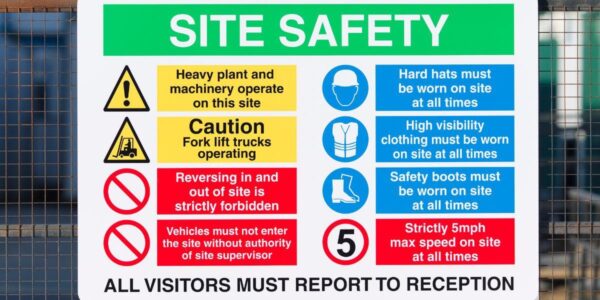
We are thrilled to hear that you’ve decided to make safety a focus at your company! Okay, we didn’t actually hear that, but the fact that you are here and taking the time to learn more about getting your safety program off the ground makes us pretty confident in the assumption that you are committed to change. This means you are officially on your way to safer job sites for your workers and being more compliant with government policies (i.e. OSHA).
It is completely understandable for you to feel confused and overwhelmed at this point; the safety industry (and the internet) tend to do that to people. No need to worry any longer; we are about to clear things up for you.
(Check out our article on what job site hazard assessments are and how they can help you keep a safe work environment.)

Here Are 5 Easy Safety Tasks All Contractors Should Be Doing:
1. Conduct and Document Weekly Toolbox Talks
A Toolbox talk, sometimes referred to as a safety meeting, is the base of any good safety program. It is a two-part process consisting of a safety lesson followed by the documentation of what was discussed, with whom, when, and where.
If you can only find time for one safety task a week, make it a toolbox talk. Conduct them with every field worker on different and relevant safety topics.
We realize it’s next to impossible to get every worker in one place at one time, ever, let alone once a week, and that’s not a problem. This talk should actually be delivered in smaller groups, ideally right on the job site, where the material, equipment, and tools you are discussing are readily available.
You can deliver these talks yourself if you are able to make it to each site on a weekly basis; otherwise, it is okay to assign this task to the supervisor or foreman of each crew. In fact, the more a crew is assigned safety responsibilities, the more likely they are to take ownership of them and put them into everyday practice.
2. Show Up Unexpectedly Onsite
This one is about as basic as it gets. If you want to really know what is going on at your job sites, you have to SHOW UP.
If your crews know you are coming, that’s okay, but it’s even better if they don’t. The more they realize it’s possible the boss shows up at any time, the more likely they are to consistently comply with the rules.
We’ve seen some supervisors park down the street and watch their crew with binoculars before they arrive at the site. Another sneaky but useful tactic is to ‘forget’ something at the site and circle back 10 min later to get it. Then, you’ll know if any compliance measures are dropped as soon as you turn your back.
You can send any of your supervisors to the site to do random checks, but the higher you are up the chain of command, the higher levels of compliance you will start to notice. These visits don’t have to be negative or unwarranted either. Dropping off coffee or running them more material are perfectly good covers for your arrival and will be appreciated by the crew as well.
3. Recognize Safety Adherence and Infractions
EVERY TIME you see a safety infraction, you need to act on it. The moment you let something slide, your employees will notice and likely won’t comply next time. This may mean you are very busy to begin with, but if you are consistent, it will improve.
If you haven’t been great at staying on top of infractions, you should give your employees fair warning that you are about to start. In your explanation, provide reasons for the change, with your concern for their personal safety topping the list.
They should also know what the consequences are if they are caught making unsafe choices. Many companies have a written policy that escalates based on the number and severity of the infraction.
Usually, the first offense warrants a verbal warning, whereas a second or third incident should definitely be documented in writing. A third or fourth offense may warrant a suspension. On the other hand, if the first offense is something that puts their life or the lives of their co-workers at risk, you may decide to skip to the second or third warning tier.
Just as important as acting on the negative is remembering to reward the good behavior. Rewards can be as simple as a high five; just knowing that the boss has noticed them is often enough.
However, gestures such as bringing them a cup of coffee on your next site visit or praising them among their peers are also effective. Some companies even run monthly leaderboards to add a dash of healthy competition.
4. Teach and Train Employees
Ideally, you should be running formal training sessions with a professional who is qualified to certify your crews in specific safety tasks. However, you can get started today by spending time on-site to teach proper, safe techniques when using equipment, material, and machines.
This is especially important when it comes to infractions. Every infraction that is handed out should be tied to some sort of training or resolution. You can give the individual the training or use it as a teachable moment for the entire crew.
There is no harm in hosting a toolbox talk on the topic, even if you’ve already done one that week. The more serious the offense, the more formal the training should be, and that may mean the employee needs to sign up for a course off-site prior to their return to work.
It is also entirely possible the issue can be corrected by the company, such as providing extra Personal Protective Equipment in each truck for when something is forgotten or breaks.
You probably already pay special attention to new workers as they obviously require help to learn the ropes, and that’s fantastic, but don’t forget about your seasoned employees, either. Where your new employees will likely display a healthy level of caution, seasoned employees can be overconfident, leading to skipped steps and high levels of risk. Reminders to slow down and to be a good example for the sake of the new workers can be very effective without damaging their pride.
5. Build a Safety Culture
A safety culture will develop naturally to some degree as you incorporate the first four tasks; however, the companies with the most success will treat safety seriously from the top down. The owners and management team need to make a commitment to safety and then walk the talk in their daily work life.
If your workers know how seriously you take safety, over time, they will do the same. But the first time you prioritize production over safety, you will undo everything you had accomplished. They will get the message that safety is just a show, and what really matters in the end is money.
We can understand the pull that you may feel to focus on results ahead of safety. It’s natural. You want your business to succeed, and that means completing work and getting paid. When it comes to your focus on safety, though, you have to play the long game.
The success of the first four tasks hinges on the strength of your commitment to safety day in and day out.
Next Steps
Other than starting each week with a short toolbox talk meeting, every other task we just covered can be worked into your existing daily routine with very little additional time required. As long as the company has provided your workers with the equipment they need to stay safe, such as safety software for construction, there really aren’t any additional costs either. So, there are no excuses as to why you shouldn’t start your program today.
We already know that your priorities are:
- To keep your workers safe and
- To reduce your company’s liability should an incident occur
And now you have the tools to act on them.
Next, you should check out our article What is a Toolbox Talk (A 2-Part Safety Meeting) to become an expert at them, or jump right in and download our Toolbox Talk Form below.
Share Article
Keep on current news in the construction industry. Subscribe to free eNews!



